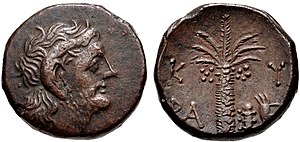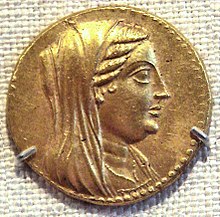Magas of Cyrene
| Magas of Cyrene | |
|---|---|
| Basileus | |
 | |
| King of Cyrenaica | |
| Reign | 276–250 BC[1] |
| Predecessor | Ophellas(local ruler) Ptolemy II Philadelphus (asPharaohofEgypt) |
| Successor | Berenice II(as Queen) andDemetrius the Fair(as King) |
| Co-regent | Berenice II[2](from 258 BC) |
| Born | c. 320 BC[3] Macedon |
| Died | 250 BC Cyrene |
| Spouse | Apama II |
| Issue | Berenice II |
| House Dynasty | Kings of Cyrene Ptolemaic dynasty |
| Father | Philip |
| Mother | Berenice |
| Religion | Greek polytheism |
Magas of Cyrene(Greek:Μάγας ὁ Κυρηναῖος;born before 317 BC – 250 BC, ruled 276 BC – 250 BC) was aGreekKing ofCyrenaica.Through his mother’s second marriage toPtolemy Ihe became a member of thePtolemaic dynasty.He managed to wrest independence forCyrenaica(in modernLibya) from the GreekPtolemaic dynastyofAncient Egypt,and became King of Cyrenaica from 276 BC to 250 BC.
Family background and early life[edit]
Magas was the first-born son of the Macedonian noblewomanBereniceand her first husband,Philip,who had served as a military officer in the campaigns ofAlexander the Great.[4]He had two younger sisters:Antigone of EpirusandTheoxena of Syracuse.[5]His father, Philip, was the son of Amyntas by a mother whose name is unknown.[6]Plutarch(Pyrrhus 4.4) implies that his father was previously married and had children, including daughters born to him.[7]Phillip served as a military officer in the service of the Macedonian kingAlexander the Greatand was known for commanding one division of thephalanxin Alexander’s wars.[8]

Magas's mother, Berenice, was fromEordeaea.[9]She was the daughter of local obscure noblemanMagasand noblewomanAntigone.[10]Berenice’s mother was the niece of the powerful regentAntipater[10]and was a distant collateral relative to theArgead dynasty.[11]He was the namesake of his maternal grandfather.
About 318 BC, Magas's father, Philip, died of natural causes. After her husband's death, Berenice took her children to thePtolemaic Kingdom,where they were a part of the entourage of Berenice's cousinEurydice.Eurydice was then the wife ofPtolemy I,the first Greekpharaohand founder of thePtolemaic dynasty.
By 317 BC, Ptolemy I fell in love with Berenice and repudiated Eurydice to marry her. Through her marriage to Ptolemy, Berenice became an Egyptian queen and the queen mother of the Ptolemaic dynasty.[12]Magas was thus a stepson to Ptolemy I; he became an Egyptian prince living in his stepfather's court and was a member of the Ptolemaic dynasty. His mother bore Ptolemy I three children: QueenArsinoe II,PrincessPhilotera,and KingPtolemy II.[13]
Governorship and kingship of Cyrenaica[edit]

Around five years after the death of the Cyrenese rulerOphellas,Magas, then about 20 years old, received the governorship of Cyrenaica from the ruling Ptolemies in Egypt: his mother Queen Berenice I and his stepfather Ptolemy I.[3]
As a posthumous honor to his biological father, Magas, when he served as a priest of the Greek GodApollo,had dedicated an honorific inscription proudly naming him as ‘the eponymous priest’ and ‘Magas son of Philip’.[14]
Following the death of his stepfather Ptolemy I in 283 BC, Magas tried on several occasions to wrest independence for Cyrenaica from his stepfather's successor, his maternal half-brother Ptolemy Philadelphus, until he crowned himself King around 276 BC.[3]It was the first time Cyrene had a king sinceArcesilaus IVaround 440 BC.[3]

Magas then marriedApama II,his third maternal cousin and one of the daughters ofSeleucid KingAntiochus I SoterandStratonice of Syria.Antiochus I used his marital alliance to foment a pact to invade Egypt. Apama II and Magas had a daughter calledBerenice II,who was their only child.
Magas opened hostilities against Ptolemy II in 274 BC, attacking Egypt from the west, as Antiochus I was attackingPalestine.[3]However, Magas had to cancel his operations due to an internal revolt of the Libyan nomad Marmaridae.[3]In the east, Antiochus I suffered defeat against the armies of Ptolemy II. Magas at least managed to maintain the independence of Cyrenaica until his death in 250 BC. Magas betrothed his daughter Berenice II toPtolemy III Euergetes,the son of Ptolemy II, as a way to seal an alliance between the two realms and secure the independence of Cyrene.[15]
After the death of Magas, Apama II broke the marital alliance between her daughter Berenice II and Ptolemy III and proposed her daughter and the throne toDemetrius the Fair,son of theAntigonidkingDemetrius I Poliorcetes,who became the new king of Cyrene.[16]This gave the Antigonids strategic control of the western side of the Ptolemaic Kingdom.[16]After Demetrius was assassinated by Berenice for cheating with her mother Apama, Berenice returned to Egypt to finally marry her originalfiancé,Ptolemy III Euergetes.[16]
Magas is known to have favored the arts and sciences in Cyrene, and was close to the philosophical school of theCyrenaics.[15]The philosophy of the Cyrenaics under Magas evolved in a way that has similarities withSkepticism,Epicurianismand alsoBuddhism.[17]
Relations with India[edit]

Magas was known by name to the contemporaryIndianEmperorAshoka,and he may have received Buddhist emissaries from India: indeed Magas is mentioned in theEdicts of Ashoka,as one of the recipients of Ashoka'sBuddhistproselytism.[15][18]Ashoka also claims that he encouraged the development ofherbalism,for men and animals, in the territories of the Hellenistic Kings.[19]

Now it is conquest by Dhamma that Beloved-of-the-Gods considers to be the best conquest. And it (conquest by Dhamma) has been won here, on the borders, even six hundred yojanas away, where the Greek kingAntiochosrules, beyond there where the four kings namedPtolemy,Antigonos,MagasandAlexanderrule, likewise in the south among the Cholas, the Pandyas, and as far as Tamraparni. Here in the king's domain among the Greeks, the Kambojas, the Nabhakas, the Nabhapamktis, the Bhojas, the Pitinikas, the Andhras and the Palidas, everywhere people are following Beloved-of-the-Gods' instructions in Dhamma. Even where Beloved-of-the-Gods' envoys have not been, these people too, having heard of the practice of Dhamma and the ordinances and instructions in Dhamma given by Beloved-of-the-Gods, are following it and will continue to do so.
There are no records of such emissaries in Western sources. However, the philosopherHegesias of Cyrene,from the city ofCyrenewhere Magas ruled inCyrenaica,is sometimes thought to have been influenced by the teachings of Ashoka's Buddhist missionaries, given the similarity of some of his teachings with Buddhism.[17][21][22]
Still, Magas probably was quite knowledgeable about India. His father, Philip, had been aphalanxofficer in the campaigns ofAlexander the Great.Later, Magas, having been raised in part at the Ptolemaic court, must also have received first-hand accounts of India from his stepfather Ptolemy I, a former general in Alexander's campaigns. The predecessor of Magas in Cyrene, the Ptolemaic governor namedOphellas,had also been one of the Alexander's officers inIndia,in charge of one of histriremesduring the expedition down theIndus River.Magas was probably quite acquainted with matters pertaining to India through his contacts with such veterans of the Indian campaigns.
See also[edit]
References[edit]
- ^Howard, Michael C. (2014-01-10).Transnationalism in Ancient and Medieval Societies: The Role of Cross-Border Trade and Travel.McFarland. p. 48.ISBN978-0-7864-9033-2.
Magas of Cyrene (Libya, r. 276–250 B.C.),
- ^Branko van Oppen de Ruiter (2016-02-03).Berenice II Euergetis: Essays in Early Hellenistic Queenship.Springer. p. 39.ISBN978-1-137-49462-7.
Remarkably, Berenice was hailedbasilissaon coins even in her father's lifetime,
- ^abcdefBerenice II and the Golden Age of Ptolemaic Egypt, Dee L. Clayman, Oxford University Press, 2014, p.30 sq.
- ^Ptolemaic Genealogy: Berenice IArchived2011-10-05 at theWayback Machine
- ^Ptolemaic Genealogy: Berenice IArchived2011-10-05 at theWayback Machine
- ^Ancient Library article: Philippus no. 5Archived2011-06-05 at theWayback Machine
- ^Ptolemaic Genealogy: Berenice I, Footnote 6Archived2011-10-05 at theWayback Machine
- ^Ancient Library article: Magas no.1
- ^Ptolemaic Genealogy: Berenice IArchived2011-10-05 at theWayback Machine
- ^abHeckel,Who’s who in the age of Alexander the Great: prosopography of Alexander’s empire,p.71
- ^Ptolemaic Dynasty - Affiliated Lines: The AntipatridsArchived2011-07-16 at theWayback Machine
- ^Berenice I article at Livius.org
- ^Ptolemaic Genealogy: Berenice IArchived2011-10-05 at theWayback Machine
- ^Ptolemaic Genealogy: Magas of Cyrene, Footnote 2
- ^abcBerenice II and the Golden Age of Ptolemaic Egypt, Dee L. Clayman, Oxford University Press, 2014, p.32 sq.
- ^abcBerenice II and the Golden Age of Ptolemaic Egypt, Dee L. Clayman, Oxford University Press, 2014, p.36 sq.
- ^abBerenice II and the Golden Age of Ptolemaic Egypt, Dee L. Clayman, Oxford University Press, 2014, p.33
- ^"The conquest byDharmahas been won here, on the borders, and even six hundredyojanas(5,400-9,600 km) away, where the Greek kingAntiochosrules, beyond there where the four kings namedPtolemy,Antigonos,Magas andAlexanderrule, likewise in the south among theCholas,thePandyas,and as far asTamraparni(Sri Lanka). "(Edicts of Ashoka,13th Rock Edict, S. Dhammika).
- ^"Everywhere within Beloved-of-the-Gods, King Piyadasi's [Ashoka] domain, and among the people beyond the borders, the Cholas, the Pandyas, the Satiyaputras, the Keralaputras, as far asTamraparniand where the Greek kingAntiochosrules, and among the kings who are neighbors of Antiochos, everywhere has Beloved-of-the-Gods, King Piyadasi, made provision for two types of medical treatment: medical treatment for humans and medical treatment for animals. Wherever medical herbs suitable for humans or animals are not available, I have had them imported and grown. Wherever medical roots or fruits are not available I have had them imported and grown. Along roads I have had wells dug and trees planted for the benefit of humans and animals. "Edicts of Ashoka,2nd Rock Edict
- ^The Edicts of King Ashoka: an English rendering by Ven. S. Dhammika.Access to Insight: Readings in Theravāda Buddhism. Last accessed 1 September 2011.
- ^"The philosopher Hegesias of Cyrene (nicknamedPeisithanatos,"The advocate of death" ) was contemporary of Magas and was probably influenced by the teachings of the Buddhist missionaries to Cyrene andAlexandria.His influence was such that he was ultimately prohibited to teach. "Jean-Marie Lafont,INALCOin "Les Dossiers d'Archéologie", No254, p.78
- ^Historical Dictionary of Ancient Greek Philosophy, Anthony Preus, Rowman & Littlefield, 2015, p.184
Sources[edit]
- W. Heckel,Who’s who in the age of Alexander the Great: prosopography of Alexander’s empire,Wiley-Blackwell, 2006
